 |
| View from Maanila Birding Lodge © Adesh Shivkar |
There is something about jungle stories which appeals to everyone regardless of age. When these stories of legendary figures like Jim Corbett are related in the veranda of the house where he lived, they become special. What really makes them come alive is when they are told by a person who has spent his lifetime in the same jungles and has had several close encounters with tigers in the wild!
 |
| Jungle Tales by Rajesh Panwar |
No wonder then, that several bystanders joined in , as we were listening with rapt attention to Mr Rajesh Panwar on the concluding day of our trip to Uttarakhand. But let me start at the beginning….
 |
A birdwatching trip was planned to a little known place called Maanila (also spelt as Manila and misunderstood as the capital of Phillipines or misread as Manali ) which is located at about 5500 feet in the Almora district of Uttarakhand state of India. It was combined with a visit to Kaladhungi and nearby areas adjoining the Corbett Tiger reserve.
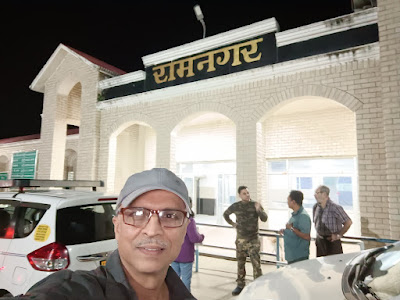 |
We started our road journey in the early hours of the morning after disembarking at the Ramnagar railway station. The first pitstop was at the roadside tea seller who was doing her bit for the environment by embracing earthen teacups or Kullhads.
 |
| The Kullhads |
The 2 hour winding journey up the hilly roads took us through several streams, as the arrangement of streams flowing over the roads seems to have been formalized in this part of the country.
 |
 |
 |
The lodge located in the village Puriachauda, is named after the local deity called Maanila Devi . The temple is said to be of 1488 vintage , built by a King of the Katyuri dynasty. The story goes that the statue of the mother Goddess (Maa) was made of a stone which had a bluish hue (Nila). A robber decided to steal the statue and carry it away. However he ended up breaking one hand of the statue. Fearing the wrath of the Goddess, he left it there and fled. The statue was restored to the temple but it was decided to build another temple where the severed hand rested. So now there are two Maanila temples; Talla (Upper) and Malla (Lower) Maanila.
 |
The birding lodge commanded splendid views of the valley below and snow-capped peaks in the distance.
 |
The area which is predominantly a Pine forest actually supports very little birdlife. However we were visited by several redbilled blue magpies Khaleej Pheasants and black headed jays, attracted by the bird bath/feeding area in the lodge.
 |
| Khaleej Pheasants |
We set out on the road towards Saraikhet which had a better diversity of tree species and consequently richer birdlife. Mixed hunting parties consisting of black throated tits, green backed tit, cinerous tits, verditer flycatchers and grey hooded warblers were immediately encountered. The presence of a large number of grey headed canary flycatchers with the characteristic 20-20 call was notable at this altitude for this time of the year.
 |
| Grey headed canary flycatcher |
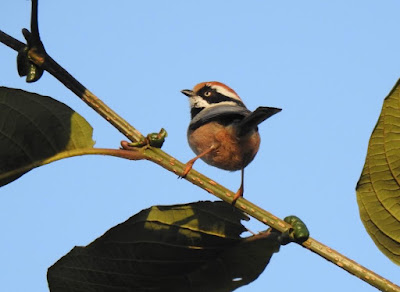 |
| Black throated tit |
 |
| Red vented bulbul-bengalensis |
 |
| Streak breasted woodpecker |
 |
| Paddyfield pipit |
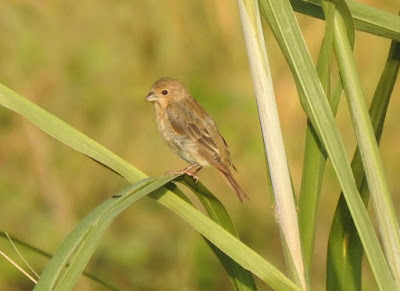 |
| Common rosefinch female |
 |
| Black redstart female |
 |
| Lineated barbet |
 |
| Common hawk cuckoo |
 |
| Changeable hawk eagle |
 |
| Blue whistling thrush |
 |
| Rufous bellied nuthatch |
 |
| White throated laughingthrush |
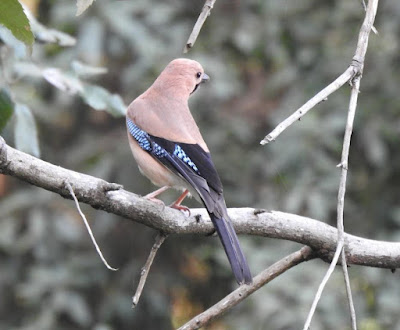 |
| Eurasian jay |
 |
| Maroon oriole |
 |
| Himalayan woodpecker |
 |
| Spotwinged Grossbeak female |
 |
| Spotwinged Grossbeak male |
 |
| Little pied flycatcher |
Things thereafter became quieter but soon we spotted a khaleej pheasant female along the side of the road which darted into the bushes. One enthusiastic participant who was unable to have a good look, decided to follow the bird in the thickets. He found nothing and after a while decided to make his way back to the vehicle. What followed next can be best described as a pheasant shower , as at least eight khaleej pheasants erupted from the bushes around him and flew away before anyone could take a photo!
 |
| The ambushman |
The sumptuous lunch at the lodge included a local delicacy called Bhatt ki Dal, made out of whole roasted soyabean. That explained the numerous soyabean fields that we encountered on the way. Can’t say I became a fan of this dish but kept worrying if the process of detoxification of soyabean was included in the recipe!
 |
| Bhatt ki Dal |
Lunch was topped up with the local Almora sweet called “toffee”, graciously provided by a participant. It was variously described as fudge, milk cake, toffee or barfi by those who tasted it, thus underlining its unique and curious quality. Suffice to say that it was very tasty and filling!
The post lunch trail was not too productive and as afternoon turned into evening, it was decided to look for the elusive mountain scops owl. It was explained that this is one owl that is always heard, but seldom sighted by even the most experienced birders.
 |
| Owling |
Though all owls are considered eerie, the reason why this one is called a “Ghost Owl” soon became clear. Apparently it has ventriloquist like abilities thereby seeming to be calling from four different directions. The tracking abilities of our driver cum guide Vivek were soon proven, as he managed to give us excellent sightings of this elusive owl.
 |
| Mountain scops owl |
Waking up in the hills to the sound of birds ( and not vehicle horns) is one of the most pleasurable experiences of birding. The blue whistling thrushes gave the wakeup call just as the sun was rising over the valley and we set out at first light.
We soon encountered noisy flocks of whitethroated laughingthrushes. A sparrow hawk was seen getting mobbed by jungle crows. A Koklass pheasant decided to give a majestic view as well.
 |
| Koklass phesanat male |
Field breakfast on the trails is usually served on the car bonnet. But every time, we get to see something new. This time it was the perfectly sized, finger like kaati rolls sealed with ketchup and mayo...and I guess lots of love.
 |
 |
| Fingerlicking delicious! |
What also caught attention was the local Hindu modification of the ubiquitous Buddhist prayer flags that one sees on the rear window of cars.
 |
| Hindu prayer flags |
The post breakfast trail was very productive and we saw several mixed hunting parties. The dark sided flycatcher and chestnut bellied niltava also gave good views. The spotted grossbeak pair created a lot of excitement and joy. But our guides did not seem very happy as they were trying to get us a glimpse of the so called target bird of the trip. The Cheer Pheasant.
 |
| Rufous bellied niltava |
Said to prefer the typical valleys of Cheer (Pine) forests which are carpeted by fallen pine needles and scanty undergrowth, they are found in large numbers and easily spotted in this area. In fact , the very reason of the discovery of this area as a birding location was thanks to this.
 |
But for today, all that we found was the other product of the Cheer forest i.e the cans of collected pine resin oozing from cuts made at the base of the trees. Something like how rubber sap is collected in Kerala.
 |
 |
| Pine sap collection |
We also spotted several stray cows and calves on the hill roads. It was learnt that since the tightening of the cow laws, nobody wants to utilize or care for them anymore. Apparently the leopards in the area are the unintended beneficiaries of this situation.
 |
| Stray cows |
We got sightings of the eureasian jay, lesser yellownape woodpecker, himalayan and rufous bellied woodpecker as we descended down the valley in search of the Cheer. Curiously the sighting which generated much excitement was that of the upland pipit which decided to show up when we had descended to the lowlands! The bird was not shy at all and perched at eye level steadfastly regardless of the passing traffic and excited birders.
 |
| Upland pipit |
That evening we ended up near the Hanuman temple , with still no sightings of the Cheer but a faint glimmer of hope as there were calls from the valley in the distance.
 |
Lumps of scat found on the temple ledge was attributed to a leopard, but that claim was contested and vigorously debated. Little did we know what was in store the next day….
 |
| Cheer pheasant male |
The next morning was nice and bright with several Khaleej foraging near the lodge and Koklass darting across the road every now and then. We headed straight for the Hanuman mandir and were soon rewarded with the sighting of the Male Cheer exactly where we expected it to be. Everyone got their fill of watching or photographing this beautiful creature. The guides were quite relieved, but one of them was now frantically waving to us….Couldn’t have been another Cheer we thought, going by his body language. It was in fact a huge male leopard in the bright morning light scurrying away from the road towards the valley. One participant managed a nice photo as the beast turned back, before disappearing into the valley.
 |
| Male leopard © Yasmeen |
After we stopped hyperventilating, someone figured that it is very unusual for a leopard to appear on the busy road in broad daylight, unless there was a reason….
And immediately the reason became clear. The stray cow that we had spotted yesterday had been hunted and was in the process of being dragged by the leopard into the valley when he got interrupted by the passing traffic. The kill, which was still fresh, was lying on the road and we decided to leave it alone so that nature could take its own course. Doubtlessly, the leopard would come and claim it at dusk.
 |
| Leopard kill |
After breakfast, we set out for our next phase of birding in the low lying areas around Kaladhungi and Nainital road . We had good sightings of the lineated barbet, little pied flycatcher, ashy bulbul, rufous bellied and velvet fronted nuthatch.
There was a sudden flurry of action around the Ramganga river crossing where we had good sightings of the white throated fantails and the grey capped pygmy wood pecker .
Also seen in a grey cap was a gentleman looking quite forlorn as he waited patiently for a bus to take him uphill. His stoic demeanor mildly betraying the years of tribulations and those to come; Rather like the smoothened rocks on the river bed in the background, with water rushing all around, patiently waiting to be eventually ground into sand and become one with the creator.
 |
| I am a Rock! |
 |
| Ramganga river |
Lunch had been planned at a newly opened eatery whose owner seemed to have a unique sense of aesthetics and décor!
 |
 |
| Wanderers.....get lost! |
It was late evening when we reached the Mileu Villa homestay. Located at the very edge of the forest in the Chhoti Haldwani area near Kaladhungi, the building construction concluded only yesterday and we were to be its first guests!
 |
The electric fence in front was meant to keep away the elephants, but as
the video footage from the CCTV camera showed, it was hardly a deterrent for
the leopard which had come calling into the courtyard a few weeks ago.
 |
| Haripura reservoir |
 |
The next mornings trail was planned to the Haripura reservoir and Bund area. The reeds around the bund held redstarts, baya weavers and rosefinches in good numbers. During winters there is an abundance of ducks significant enough to warrant an anti-poaching check post.
 |
Since this was still not winter, we had to make do with the occasional coots and pintails. The highlight of these reeds was however the yellow bellied warbler and the rufous capped babbler which gave splendid views.
 |
| Rufous capped babbler |
 |
| Yellow bellied warbler |
The afternoon was spent along the Kotabagh and Nainital roads looking for the slaty gray woodpecker which did not oblige.
Waking up early next morning to the sounds of a softly gurgling brook nearby
and sipping tea in the balcony with complete absence of city sounds, made one
almost jealous of the local dwellers. The morning trail along the Kotabag road
was very productive. The Great pied hornbills also decided to do a flypast. The
crimson sunbird display in the bright morning sunshine was the superlative
icing on the cake. We proceeded deep into the remote hills to Pandegaon and beyond on a road which
was only a cattle track till two years ago. There was a delightful sighting of
the pale bellied flowerpecker. Flocks of white crested laughingtgrushes
punctuated a delightful morning of birding before we retraced our steps to the
valley where the great slaty woodpecker was expected.
 |
| Pale billed flowerpecker |
 |
| Crimson sunbird male |
 |
We waited patiently for a long time but to no avail. Our guide who is as adept at storytelling as he is at birdguiding , filled these gaps with fascinating stories of yore. The stream that we were now looking at, was actually made in the mid nineteenth century to feed the iron foundry which existed here. The ore was locally found, the water diverted from the river and the fuel came by felling the Sal forest. The environmental impact of this wholesale treefelling was realized by the Commissioner of the Kumaon division, Sir Henry Ramsay. He ordered a closure to this practice and may have saved the entire ecology from being destroyed.The town of Ramnagar is actually named after him and not the other Ram…
Just as things were getting dull a phonecall was received and our guides seemed electrified.
We have all heard of policemen having informers. Apparently in the hills, the bird guides also have informers. Except that the subject of the information is not criminals, but sightings of target birds. It was revealed that about five years ago, a wayside stall came up in a location were the slaty great woodpecker was often found. This curiously named maggi point was owned by an enterprising gentleman who realized that if he was able to give information about the sighting of the woodpecker, it would result in increased footfall at his establishment! And so continues the symbiotic relationship of which we were the beneficiaries today.
 |
 |
| Great slaty woodpecker male |
Only once we sighted the enormous woodpecker sitting frozen on its perch, did we realize what the fuss was all about. Just that this was the largest woodpecker in the world!!! The last trail of the trip yielded excellent views of the streaked throated wookpecker pair right outside the homestay.
Fully satiated with the sightings and the nimbu pepper pani served by the scooterwala maggi man, we now proceeded to the Corbett museum at Chhoti Haldwani. We went past the old bridge on the Baur river which is of 1899 vintage.
 |
| The Old bridge on the Bauer |
Few Britishers have had such a deep and long lasting influence on the lives of the people more
than seventy years after they left the country as has Jim Corbett. To say that his soul still
happily wanders this part of Uttarakhand state of northern India would not be
an exaggeration. The entire village of Chhoti Haldwani which he had purchased
was handed over by him to the villagers when he left for Africa on the
insistence of his sister after 1947. His residence, converted into a museum,
stands today as proud testimony to the life and times of Carpet Saheb. Visited
by casual tourists, who may find nothing spectacular here, as well as nature
enthusiasts who get goosebumps when they see the enormity of the polymathic personality
that was Jim Corbett.
Tour Dates: 12 Oct 22 to 16 Oct 22
Tour organizer: Natureindia
Local experts: Mr Rajesh Panwar and Mr Vivek Rawat
Stay: Manila Birding Lodge, Almora District and Mileu Villa, Kaladhungi.
Camera: Nikon P900 and Oneplus Nord2
Travel alert: The train leaves from Old Delhi Railway station at 2200. There is an unimaginable jam just outside the station every day for no particular reason. One participant missed the train inspite of keeping a 2 hour cushion. The return train is supposed to reach at 0400. It didn’t. Another participant missed their flight inspite of a 3 hour cushion, that too on Diwali day!
 |
| Corbett museum |
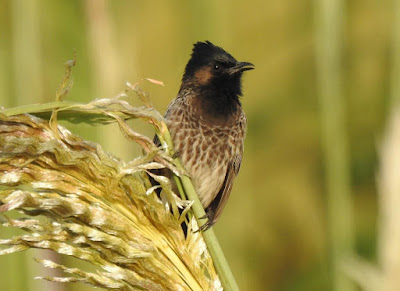













No comments:
Post a Comment